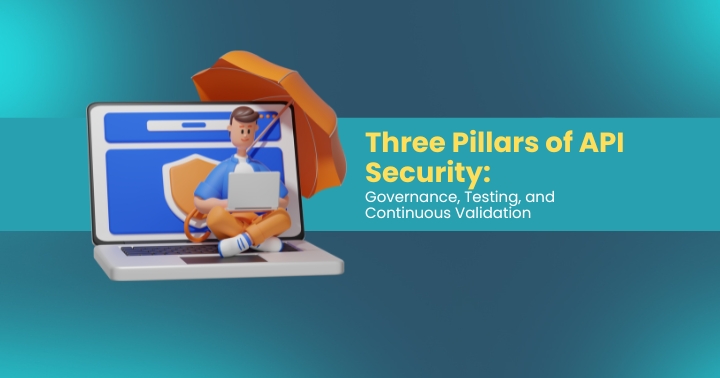APIs are the backbone of modern digital ecosystems, enabling applications to seamlessly communicate with each other. With this increased reliance on APIs, securing them has become more crucial than ever. API security isn’t just about fixing vulnerabilities; it’s about building a comprehensive strategy that addresses security across every phase of the API lifecycle. This strategy is built around three key pillars: governance, testing, and continuous validation.
The Three Pillars of API Security
To build a robust API security program, you need more than just patching holes. A holistic approach should touch on governance, testing, and continuous validation.
1. Governance: Defining Secure API Development Practices
The first pillar of API security is governance. Governance is all about defining, enforcing, and maintaining consistent security practices for API development, deployment, and maintenance. Without proper governance, APIs can easily become mismanaged, leading to inconsistencies in security protocols, over-permissioned APIs, and the introduction of vulnerabilities.
Effective API governance involves several key practices:
- API Design and Standards: Establishing security standards from the beginning of the API design process ensures that security is built into the API from the ground up. This includes defining clear security protocols for authentication, authorization, and data encryption.
- API Documentation: Clear documentation not only makes it easier for developers to build secure APIs, but it also helps to ensure that security practices are consistently followed.
- Enforcing Policies: Governance involves enforcing security policies at every stage of the API lifecycle, from design to testing to production. Regular audits and reviews of API usage and configurations are crucial to ensuring compliance with security policies.
2. Testing: Identifying Vulnerabilities Before They Are Exploited
The second pillar of API security is testing. API testing ensures that your APIs perform as expected and are free from vulnerabilities that could be exploited by attackers. This includes checking for both functional and security flaws.
API testing can be divided into two main categories:
- Functional Testing: Verifies that the API works as intended and that the business logic behind it is implemented correctly. This can include tests for response times, input validation, and error handling.
- Security Testing: Identifies vulnerabilities such as broken object-level authorization (BOLA), excessive data exposure, and authentication flaws that attackers can exploit. Testing tools should be used to simulate potential attacks and uncover weak points in the API.
For ongoing testing, APIsec.ai offers automated API testing, continuously identifying vulnerabilities and misconfigurations throughout the API lifecycle. This proactive approach is essential for uncovering risks early and ensuring that your APIs remain secure even as they evolve.
Read our blog to learn how you can integrate APIsec.ai into your CI/CD pipeline and ensure that vulnerabilities are identified and addressed before the API is deployed to production.
3. Continuous Validation: Ensuring Ongoing API Security
The third pillar of API security is continuous validation. Unlike traditional monitoring tools that only detect issues after they’ve occurred, continuous validation proactively verifies API security before vulnerabilities can be exploited.
Continuous validation involves:
- Ongoing Testing: APIsec’s automated security tests run continuously, validating every stage of the API lifecycle to ensure vulnerabilities are identified and mitigated before they make it to production.
- Prevention Over Detection: Unlike monitoring solutions that only identify breaches after an attack, APIsec focuses on prevention, eliminating vulnerabilities during development and ensuring that APIs are secure from the start.
- Integrated with CI/CD: By automating security checks and integrating them into the CI/CD pipeline, APIsec ensures that every code change is tested for security flaws in real-time, enabling proactive risk management.
Learn more about APIsec - the Only Platform for Automated API Security Testing and how continuous validation ensures ongoing protection for your APIs.
Conclusion
API security is essential to protecting sensitive data and ensuring smooth business operations. The three pillars of governance, testing, and continuous validation work together to create a robust security program that safeguards APIs from development through deployment and beyond.
With tools like APIsec, organizations can implement automated testing, enforce strong governance policies, and continuously validate API security, making API security an integral part of the development lifecycle.
To ensure your APIs are secure, sign up for APIsec and start automating your API security today. Stay ahead of threats and ensure your APIs remain a source of innovation, not risk.
FAQs
What are the three pillars of API security?
The three pillars of API security are governance, testing, and continuous validation. These pillars work together to ensure that APIs are developed, tested, and maintained securely throughout their lifecycle.
Why is API testing important?
API testing ensures that APIs perform as expected and are free from vulnerabilities. It helps identify issues such as broken authentication, excessive data exposure, and other flaws that could be exploited by attackers.
How does continuous validation help in API security?
Continuous validation ensures that APIs are secure from the start by proactively identifying vulnerabilities before they can be exploited. This approach prevents security flaws from making it to production, unlike traditional monitoring tools that detect issues after they occur.
How can APIsec help with API security?
APIsec provides automated API security testing, continuous validation, and governance enforcement, helping businesses detect vulnerabilities, prevent attacks, and ensure their APIs remain secure at all times.
.webp)

.webp)
_%20OWASP%20API%20Security%20Principle%20%237%20Explained.jpg)
